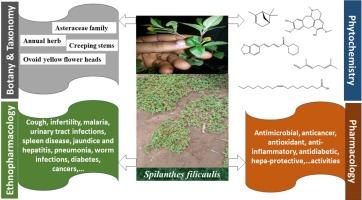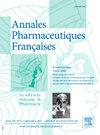Spilanthes filicaulis (Schumach. &Thonn.) C. D. Adams: An insights into ethnopharmacologically important but scientifically understudied species
IF 1
Q4 PHARMACOLOGY & PHARMACY
引用次数: 0
Abstract
Spilanthes filicaulis (Schumach. & Thonn.) C. D. Adams is synonymous to Acmella caulirhiza Delile. The plant, also known as cock's eye or African cress, is a medicinal herb that belongs to the Asteraceae family. In this paper, the holistic and current applications of S. filicaulis were synthesized and critically discussed by summarizing, for the first time, its botany, traditional medicinal uses, active components, and pharmacological properties. We employed the databases of ScienceDirect, Scopus, Online Wiley library, PubMed, and Google Scholar to retrieve data on S. filicaulis from inception till February 2024, resulting in more than 70 electronic references. Based on literature reports, S. filicaulis has rich ethnopharmacological uses in different disease areas but their scientific validations are still in early stage, or not verified yet. In general, 16 phytochemicals have been identified so far. They include spilanthol, piperine, erucic acid, and isoquinoline derivative among others. The plant extracts possess anticancer, antioxidant, antimicrobial, anti-inflammatory, hepato-protective, anthelminthic, and analgesic activities. In the future, the phytochemical components, and biological activities of S. filicaulis need to be further investigated. Similarly, mechanistic studies need to be incorporated to the biological testing, to uncover the modes of actions of the species extracts and active components. Considering the species’ rich ethnopharmacological applications, and the dearth of robust and established toxicity reports, the study on the safety of S. filicaulis would be an interesting and rewarding approach for further research.
Spilanthes filicaulis (Schumach. & Thonn.) C. D. Adams est synonyme d’Acmella caulirhiza Delile. La plante, également connue sous le nom d’œil de coq ou cresson d’Afrique, est une plante médicinale appartenant à la famille des Astéracées. Dans cet article, les applications holistiques et actuelles de S. filicaulis ont été synthétisées et discutées de manière critique en résumant, pour la première fois, sa botanique, ses utilisations médicinales traditionnelles, ses composants actifs et ses propriétés pharmacologiques. Nous avons utilisé les bases de données de ScienceDirect, Scopus, la bibliothèque en ligne Wiley, PubMed et Google Scholar pour récupérer des données sur S. filicaulis depuis sa création jusqu’en février 2024, ce qui a donné lieu à plus de 70 références électroniques. D’après les rapports de la littérature, S. filicaulis a de riches utilisations ethnopharmacologiques dans différents domaines pathologiques, mais leurs validations scientifiques en sont encore à leurs débuts ou ne sont pas encore vérifiées. En général, 16 composés phytochimiques ont été identifiés jusqu’à présent. Ils comprennent, entre autres, le spilanthol, la pipérine, l’acide érucique et le dérivé de l’isoquinoléine. Les extraits de plantes possèdent des activités anticancéreuses, antioxydantes, antimicrobiennes, anti-inflammatoires, hépato-protectrices, anthelminthiques et analgésiques. À l’avenir, les composants phytochimiques et les activités biologiques de S. filicaulis devront faire l’objet d’études plus approfondies. De même, des études mécanistiques doivent être intégrées aux tests biologiques, pour découvrir les modes d’action des extraits d’espèces et des composants actifs. Compte tenu des riches applications ethnopharmacologiques de l’espèce et du manque de rapports de toxicité solides et établis, l’étude sur la sécurité de S. filicaulis constituerait une approche intéressante et enrichissante pour des recherches ultérieures.

Spilanthes filicaulis (Schumach. &Thonn.) C. D. Adams:对民族药理学上重要但科学上研究不足的物种的见解。
Spilanthes filicaulis (Schumach. & Thonn.) C. D. Adams 与 Acmella caulirhiza Delile 同源。这种植物又名鸡眼或非洲芹,是一种药用植物,属于菊科。在本文中,通过首次总结 S. filicaulis 的植物学、传统药用、活性成分和药理特性,对其整体和当前应用进行了归纳和批判性讨论。我们利用 ScienceDirect、Scopus、Online Wiley library、PubMed 和 Google Scholar 等数据库检索了 S. filicaulis 从开始到 2024 年 2 月的数据,共获得 70 多条电子参考文献。根据文献报道,S. filicaulis 在不同疾病领域具有丰富的民族药理学用途,但其科学验证仍处于早期阶段,或尚未得到验证。总的来说,目前已鉴定出 16 种植物化学物质。其中包括斯皮兰醇、胡椒碱、芥酸和异喹啉衍生物等。这些植物提取物具有抗癌、抗氧化、抗菌、消炎、保肝、驱虫和镇痛活性。今后,还需要进一步研究 S. filicaulis 的植物化学成分和生物活性。同样,还需要在生物测试中加入机理研究,以揭示该物种提取物和活性成分的作用模式。考虑到该物种丰富的民族药理学应用,以及缺乏可靠和成熟的毒性报告,对 S. filicaulis 的安全性研究将是一个有趣和有益的进一步研究方法。
本文章由计算机程序翻译,如有差异,请以英文原文为准。
求助全文
约1分钟内获得全文
求助全文
来源期刊

Annales pharmaceutiques francaises
PHARMACOLOGY & PHARMACY-
CiteScore
1.70
自引率
7.70%
发文量
98
期刊介绍:
This journal proposes a scientific information validated and indexed to be informed about the last research works in all the domains interesting the pharmacy. The original works, general reviews, the focusing, the brief notes, subjected by the best academics and the professionals, propose a synthetic approach of the last progress accomplished in the concerned sectors. The thematic Sessions and the – life of the Academy – resume the communications which, presented in front of the national Academy of pharmacy, are in the heart of the current events.
 求助内容:
求助内容: 应助结果提醒方式:
应助结果提醒方式:


